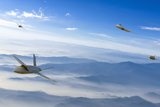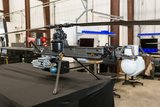German Navy in “ramp-up” phase as it welcomes first NH90 Sea Tiger delivery
With all 31 aircraft set to be delivered by 2030, the helicopters will gradually replace the ageing Sea Lynx fleet which are due to be retired in 2026.
The first Pegasus is scheduled to enter service in 2026. (Photo: Hensoldt)
The Pegasus (Persistent German Airborne Surveillance System) SIGINT platform has passed critical design review which means it has the green light for implementation of system design.
The approval came after representatives of the Bundeswehr, both from the procuring agency and future user, examined the design of the SIGINT components of the PEGASUS weapon system.
This followed a detailed presentation of implementation planning for the system's extensive requirements. At the same time, progress of the overall project was confirmed in software and hardware demonstrations.
As part of the review subcontractor Lufthansa Technik, Hamburg, outlined its integration of the reconnaissance system into the aircraft and the conversion process.
The order is worth over EUR1 billion (US$1,1 billion) with Hensoldt acting as prime contractor. Lufthansa Technik is procuring the aircraft from manufacturer Bombardier, carrying out modification, and fitting and integrating the reconnaissance system developed by Hensoldt into the aircraft.
The Pegasus project aims to fulfil a German SIGINT capability which has been missing since the retirement of five Breguet BR1150 Atlantic aircraft in June 2010.
Until 2019, Germany had intended to introduce four SIGINT-configured MQ-4C Tritons to fulfil this capability but decided in favour of procuring crewed aircraft instead, in part due to concerns over airspace use.
The first Pegasus is scheduled to enter service in 2026.

With all 31 aircraft set to be delivered by 2030, the helicopters will gradually replace the ageing Sea Lynx fleet which are due to be retired in 2026.

How RTX is equipping the military airspace – for today’s fleet and tomorrow’s fight.

German, French and Spanish leadership set an end-of-year deadline to decide the fate of the Future Combat Air System programme which has struggled with a political stalemate for the latter half of 2025.

The order for the extra helicopters comes from an agreement penned in December 2023, with the German Army receiving the bulk of the platforms.

The pair will submit their demonstrator concept for Project Nyx, a development project for the British Army’s Land Autonomous Collaborative Platform.

The Picatinny Common Lethality Integration Kit is designed to overcome the issue of unique integration methods between lethal payloads and drones as well as avoiding problematic acquisition conditions created by vendor lock.